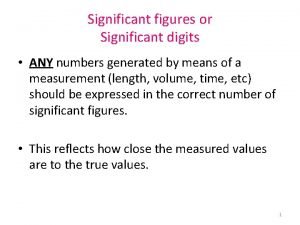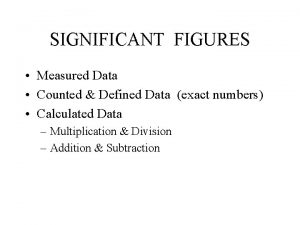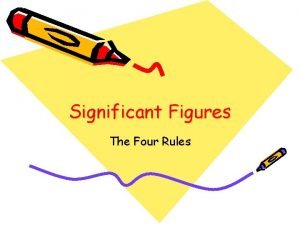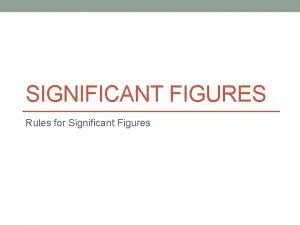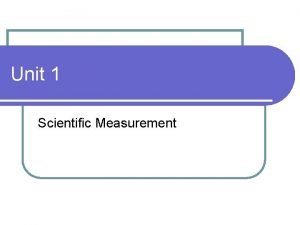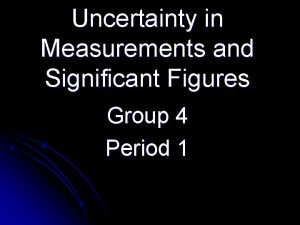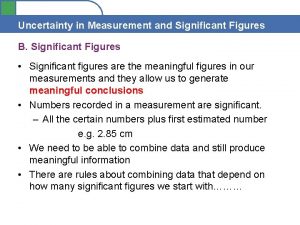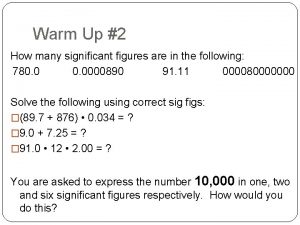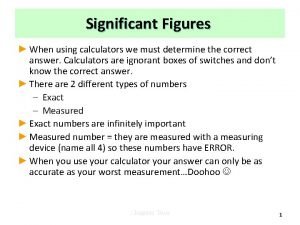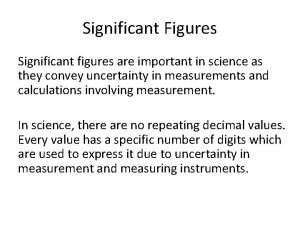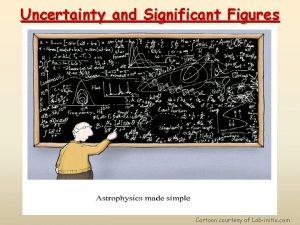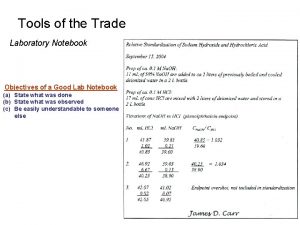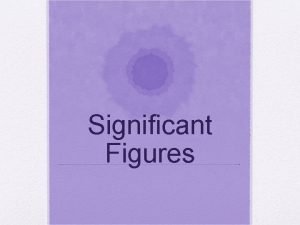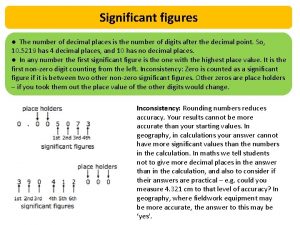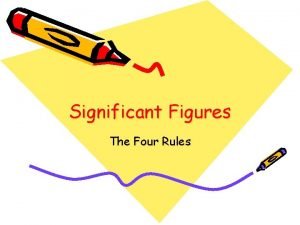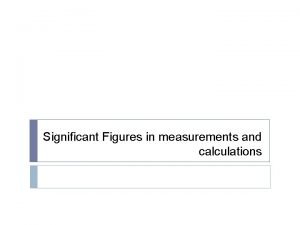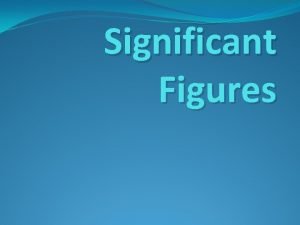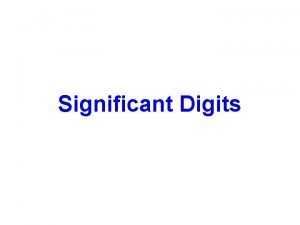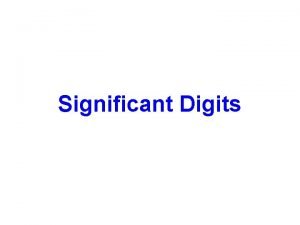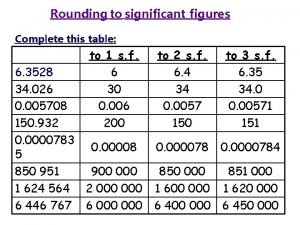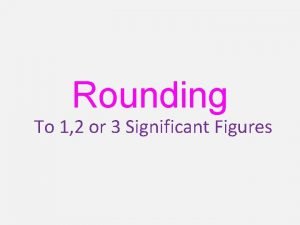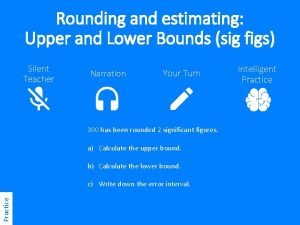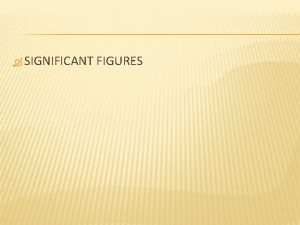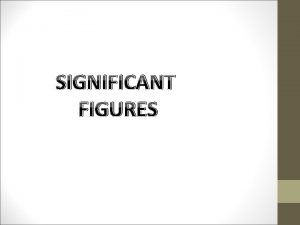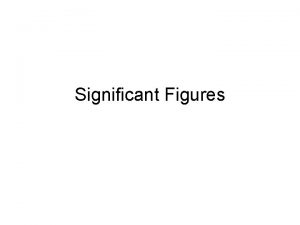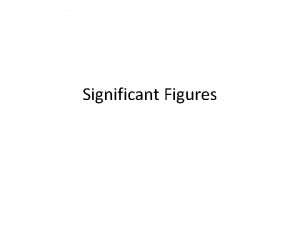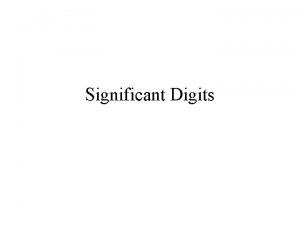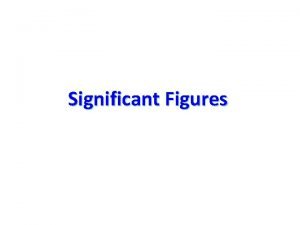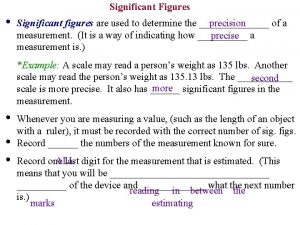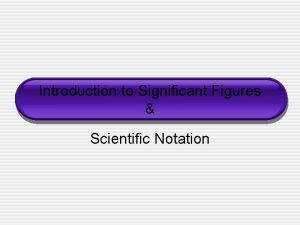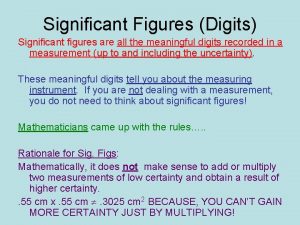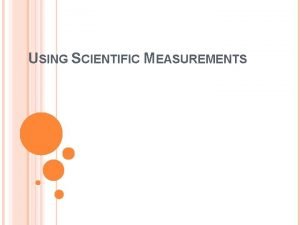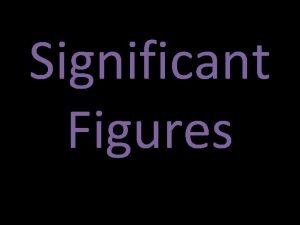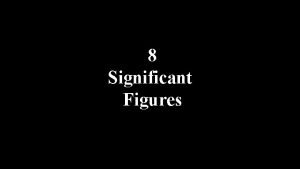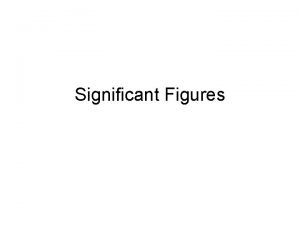Rules for Use of Significant Figures If you
































- Slides: 32

Rules for Use of Significant Figures

If you calculate the area of a parcel of land 94. 53 m long and 63 m wide, your calculator tells you the area is 5, 955. 39 m 2.

But, if you’re certain of one length only to the closest meter (63), how can you be certain of the area to the hundredth of a square meter (5, 955. 39)?

Likewise, if we add three measured values of length: 24. 3 cm 1. 245 cm + 103 cm we can’t know the total length, with certainty, to any precision greater than the whole cm.

Obviously, we have to use care in calculating with measured values.

Significant figures relate to measurements and include all certain digits plus one and only one uncertain digit (the estimated digit).

Defined numbers and counting numbers are not measurements and contain an unlimited number of significant figures(they are exact numbers). Examples: Number of pounds in a ton equals exactly 2000 Number of cards in a deck equals exactly 52

Counting Significant Figures

The digits 1, 2, 3, 4, 5, 6, 7, 8, and 9 are always significant.

27, 356 (5 significant figures) 49. 2 (3 significant figures) 81. 6762 (6 significant figures)

Zeros are not significant at the end of a whole number which does not have a decimal point (they are place-holders). Examples: 3400 (2 significant figures) 2000 (1 significant figure)

Zeros are not significant at the beginning of a deci-number which does not have a whole number (they are placeholders). Examples: 0. 0034 (2 sig fig) 0. 0002 (1 sig fig)

All other zeros are significant. Examples: 3400. (4 sig figs) 200. 0 (4 sig figs) 1. 0034 (5 sig figs) 2. 00020 (6 sig figs)

Special case - when some zeros are significant and some are not, use a line to show which ones are. Examples: 3400 (3 sig fig) 2000 (2 sig fig)

Or, even better, use scientific notation to show which zeros are significant. The “M” part of the number is always written using significant figures. 3400 (to 3 sig figs) is 3. 40 x 103

Significant Figures in Calculated Answers The precision of a calculated answer is limited by the least precise measurement used in the calculation.

Addition & Subtraction

Find the last precise value in each quantity to be added or subtracted (the colored numbers below). 7003 mm 21. 2 mm + 130. 00 mm 7154. 20 mm = 7154 mm

The ones place is the last digit in the least precise measurement 7003 21. 2 + 130. 00 7154. 20 = 7154 Therefore, the ones place is the last digit in the answer.

In a subtraction problem such as: 597. 0 m - 56. 742 m 540. 258 m = 240. 3 m the tenths place is the last place to have a digit in the answer.

Multiplication & Division

Determine how many significant figures there are in each number to be multiplied or divided.

Determine which of these has the least number of significant figures.

This is the number of significant digits to keep in the final answer.

Multiplication 3020. 1 m (5 significant figures) x 2. 0 m (2 sig fig) 6040. 2 m 2 = 6000 m 2 (= 6. 0 x 103 m 2) 2 is the least number of significant figures. So, keep 2 sig figs in the final answer. The line indicates that the first zero is significant, and the last two are place holders.

Division 50830 cm 201 = 253 cm (4 significant figures) (3 sig figs) 3 is the least number of significant figures. So, keep 3 sig fig in the final answer.

Rules for Rounding:

If the digit immediately to the right of the last significant figure you want to retain is greater than 5, increase the last digit by 1.

497. 356 (to 4 significant figures) is 497. 4

If the digit immediately to the right of the last significant figure you want to retain is less than 5, do not change the last digit.

8442. 63 (to 3 significant figures) is 8440 The 0 is a place holder and is not a significant digit.

 Round off rule of 5
Round off rule of 5 Rules of significant figures
Rules of significant figures What is a significant digit
What is a significant digit Significant numbers
Significant numbers Sig figs rules
Sig figs rules Measurement homework
Measurement homework Significant figures rules
Significant figures rules Significant figures rules
Significant figures rules How many sig figs in 780
How many sig figs in 780 How to tell significant figures
How to tell significant figures Why are significant figures important in science
Why are significant figures important in science What are significant digits
What are significant digits How you use ict today and how you will use it tomorrow
How you use ict today and how you will use it tomorrow Is ap chemistry hard
Is ap chemistry hard Certain vs uncertain digits
Certain vs uncertain digits Sig fig calculator
Sig fig calculator Sig figs division
Sig figs division Atlantic pacific rule
Atlantic pacific rule What is significant figures in maths
What is significant figures in maths Sig figs division
Sig figs division 564 to 1 sf
564 to 1 sf Significant figures
Significant figures Sig figs in 150
Sig figs in 150 What is a significant figure in chemistry
What is a significant figure in chemistry Scientific figures definition
Scientific figures definition 3 significant figures examples with answers
3 significant figures examples with answers When is zero a significant figure
When is zero a significant figure Sig figs with decimals
Sig figs with decimals What is the purpose of significant figures
What is the purpose of significant figures Significant figures meaning
Significant figures meaning Sig fig table
Sig fig table How to round to 3 significant figures
How to round to 3 significant figures Lower bound 2 significant figures
Lower bound 2 significant figures
